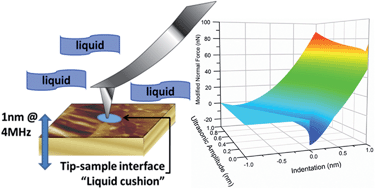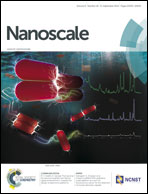Probing nanoscale graphene–liquid interfacial interactions via ultrasonic force spectroscopy†
Abstract
We probe the interfacial forces in graphene–air and graphene–liquid environments with nanoscale resolution. Experimentally, probe ‘snap-in’ to contact, in scanning probe microscopy, is overcome by combining the ultrasonic force spectroscopy (UFS) approach and MHz frequency range harmonic oscillation of the sample thereby sweeping the tip-surface dynamically from separated to indented state across the region of intimate interface contact. We measured the force interaction between nanoscale probe tip and graphene, graphite and reference SiO2 surface in ambient, polar and non-polar liquid environments. Via modelling we estimated the decay length of the force interaction in water to be 0.25–0.75 nm, equivalent to 1–3 monolayers, and interfacial effective stiffness at these distances associated with the liquid layer was an order of magnitude greater for non-polar than for polar liquid environment. During the elastic indentation at increased forces, the effective Young's modulus of graphene was shown only to be slightly reduced in ambient environment while experiencing significant reduction by a factor of 3 in non-polar dodecane environment.


 Please wait while we load your content...
Please wait while we load your content...